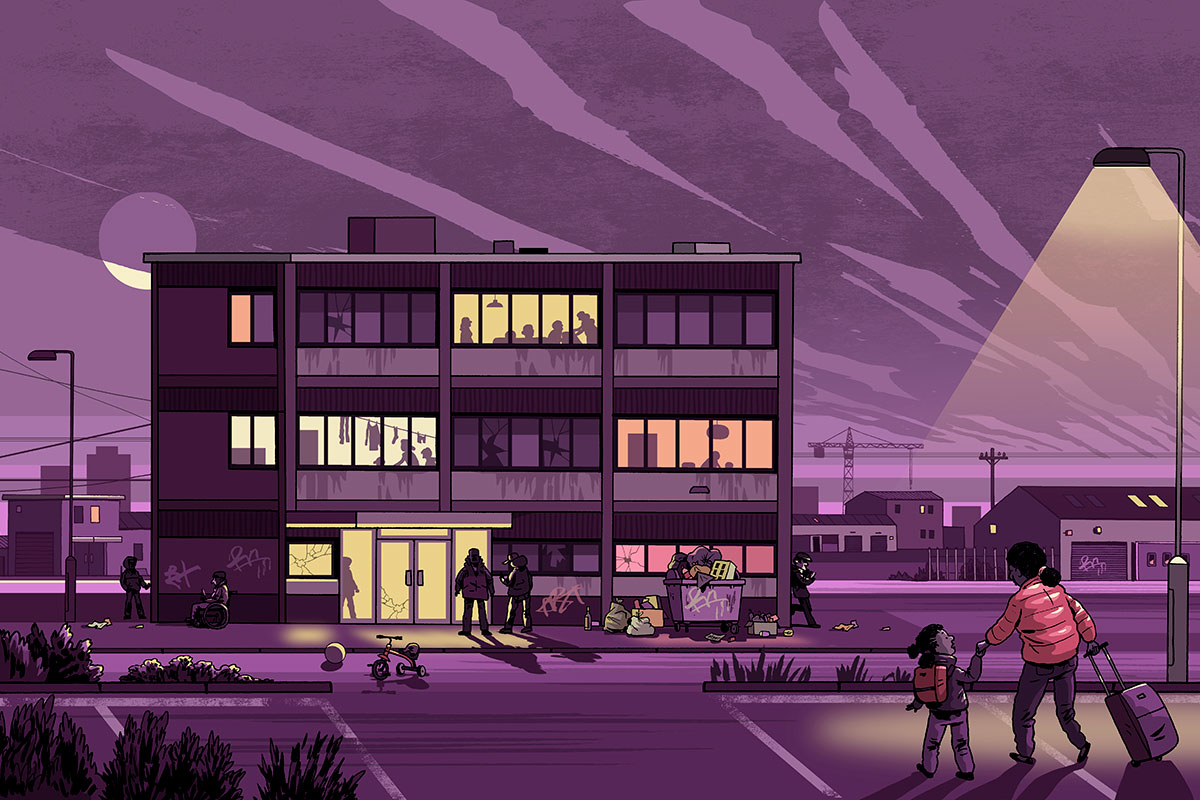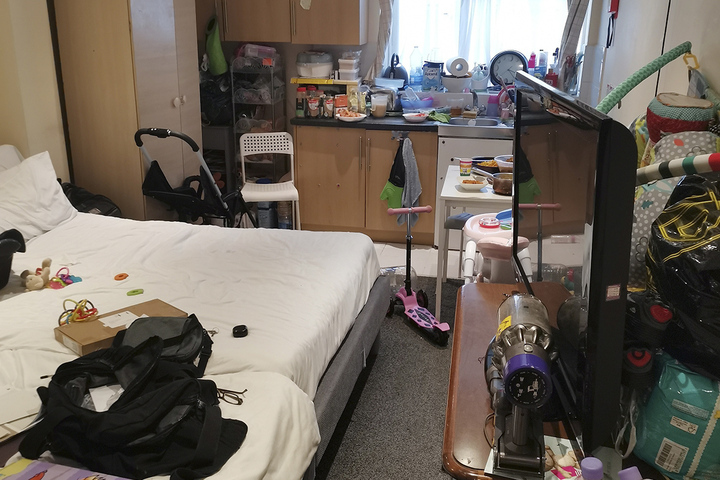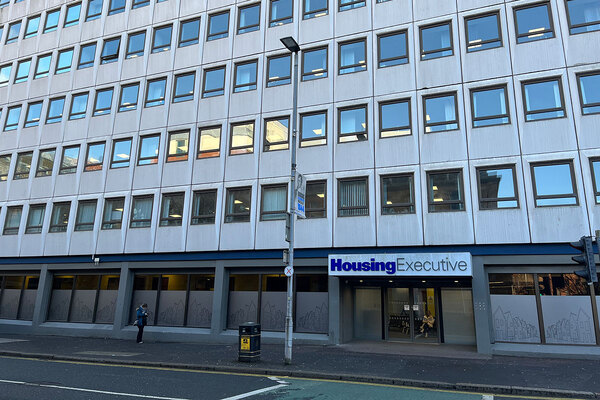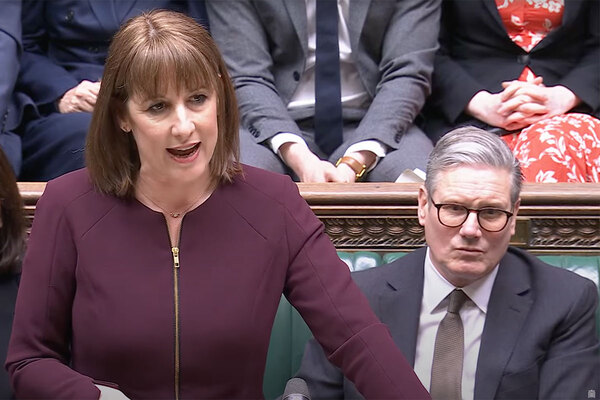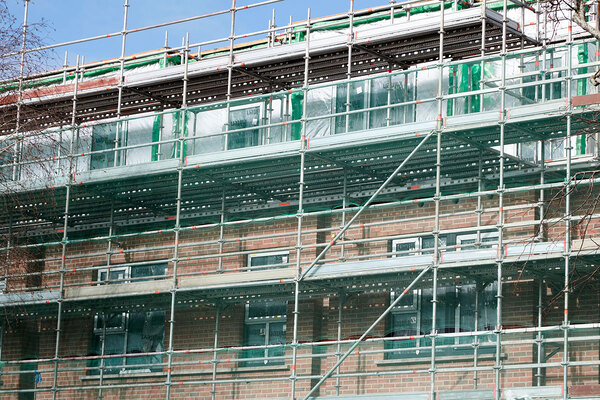The office-to-residential conversions which have become slum housing
Poorly converted office blocks are putting people in temporary accommodation at risk of serious harm. Peter Apps reports. Illustration by Scott Garrett
The building looks like a derelict office block on a quiet residential street. But it isn’t. Dozens of families live here in north London: a mix of asylum seekers awaiting a determination on their claim and homeless residents housed by various London boroughs.
The former office block has more than 50 flats. When Inside Housing visited in April, there was a large stain in the entrance hall; residents say it was left by sewage which had poured through the ceiling. This was far from the only defect. On the fifth floor, we found a broken fire door leading to the stairs. The catch had been broken off and the fireproof window smashed out.
One woman, an asylum seeker, spoke to Inside Housing from her studio flat on the top floor. “There was mould all over the ceiling and the toilet. I complained to Finefair [the agency providing accommodation on behalf of the Home Office] and they came and looked at it, but nothing changed,” she said.
Her three-year-old son “had a cough and an infection from the mould and allergies”. She was nine months pregnant when she spoke to Inside Housing and was concerned about bringing a baby to the studio flat, which is already home to her partner and son.
On the ground floor, another asylum seeker resident told us she feared for the safety of her two-year-old daughter. “There was a stabbing just outside the building. If you come here in the evening, you will smell people smoking drugs. I don’t feel comfortable making my little one grow up here,” she said.
She had made the place homely, with pictures of her daughter and decorations on the wall. But she, too, had serious damp problems. “My little one was seriously ill. Just after her birthday last November, she was hospitalised due to a chest infection, and was on penicillin for 10 days. We complained a lot to the Home Office, but nothing was done,” she said.
She works at a nearby hospital and is training to be a nurse, but her partner is barred from working by immigration rules. “I’m glad there is a roof over [my daughter’s] head, but even though we are asylum seekers, we shouldn’t have to live in a place like this.”
In April, Finefair told Inside Housing it had “carried out several damp treatments at the properties in question”.
“Due to the overall condition of the building, we are already in the process of relocating tenants and handing back the property to the landlord,” it added.
Unfortunately, we can’t name this building and the landlords involved. Two private landlord companies are involved, one which owns the freehold and one which owns leaseholds on a number of the flats. The companies are run by two former business partners. When Inside Housing approached them for comment in April, one did not respond and the other sent a response from their lawyers, with threats to sue if they were named in an article discussing the housing conditions. While Inside Housing would be confident of defending its journalism, the cost and time involved in the legal action would be difficult for an organisation of our size.
However, even without being named, this building tells a story about the conditions the poorest residents in London endure and the difficulty they have in holding their landlords to account. This block is far from unique. Two factors have combined over the past decade to create this modern generation of slum housing.
First, in 2013, planning minister Nick Boles came up with a clever fix to the joint problems of a slowdown in residential construction and an increasing number of empty and derelict offices which were a legacy of the global financial crisis. The offices would be turned into homes, and developers would no longer need planning permission to do so.
Analysts said the move would be “particularly attractive to the less-experienced landowner/investor”, who may have been “put off by a sometimes complicated and costly planning application process”.
Second, a combination of the faltering economy and insecure private rented housing meant more and more households were becoming homeless. But when they approached their local authority for help, shortages of social housing meant they frequently could not be housed in the social sector, and new caps on benefits meant they could not be housed privately.
For those with a priority need (parents, including pregnant women, those fleeing domestic violence, those leaving care and those with certain illnesses and disabilities), the local authority is legally obliged to offer emergency temporary housing. With nowhere to move to permanently, these stays started to become very long.
The numbers in temporary accommodation went up every year: 48,240 households at the start of 2011 has increased to a staggering 104,510 at the start of 2023.
Councils, faced with bank-breaking costs for hotel rooms to house this enormous homeless population, looked for the cheapest options. And so a new market was created for the cheapest housing, just at the moment the conversion of offices into homes was deregulated.
48,240
Households in temporary accommodation in 2011
104,510
Households in temporary accommodation in 2023
Demand and supply had the effect economists predicted, and these new office conversions became the destination for tens of thousands of homeless mums with nowhere else to go, rather than the new homes for young professionals Mr Boles had promised. And these conversions were also carried out by “less experienced” opportunistic investors, as predicted.
The consequences have been serious. Inside Housing saw a letter from Medact, a medical charity which assessed residents at an office conversion in north London (privately rented, but not in use as temporary accommodation) with serious damp and mould issues.
The charity interviewed 10 households and found “respiratory problems, cardiovascular health problems, allergies, mental health and sleep problems” which had begun since residents moved into the property.
It added: “We have also encountered infants with persistent respiratory issues that prevented them from sleeping, therefore affecting their performance at school. A number of infants have also been provided with inhalers due to the new onset of respiratory conditions and wheeze.
“None of them required inhalers before moving into the property. This is deeply concerning and appears to be a direct result of the conditions the landlord is housing the tenants in.”
Jordi López Botey, economic justice and health campaign programme lead at Medact, says: “We see a lot of [office-to-residential] conversions without proper ventilation, which means a lot of condensation will build up, and the type of office window they have means tenants cannot properly ventilate it.
“But because of the nature of the block, and trying to squeeze as much money as they can from it, they build very, very small rooms. This means that the type of tenants it attracts are people who would not be able
to find any other accommodation.”
He says this includes residents who have recently arrived in the country, are in precarious jobs or are on benefits, and so are unable to rent through the private sector, due to the requirements for deposits and documentation.
Vulnerable residents
Dr Amaran Uthayakumar-Cumarasamy, a children’s A&E doctor and a volunteer at Medact, adds: “The office conversions are usually going to be populated by those who are especially vulnerable. You’ve got people living in homes that have fundamentally not been designed to accommodate people in good health.
“The issue we have with things like inhaler prescribing to residents in conditions like this is that it’s putting a sticking plaster over what we know is a very deep-seated, underlying problem. I had a 10-day-old baby come in with respiratory issues last week, who was in temporary accommodation, but it’s very unlikely that will be dealt with. The chances are we’ll be seeing that child again and again in the months and weeks ahead.”
He adds the problems extend beyond mould and ventilation, with mental health, in particular, affected. “We tend to see disproportionately high levels of anxiety and depression, but also impacts on other really important core aspects, like schooling,” he says.
Overheating is also a problem. These buildings are often single aspect, with poor ventilation, and will get very hot in summer. This is a particular risk for older residents and babies.
“For older people, the risk would be things like heatstroke, which you might also see for babies, but overheating is going to enable an inflammatory cascade,” says Dr Uthayakumar-Cumarasamy.
“That’s going to have all manner of other downstream impacts on their cardiovascular health [and] respiratory health issues around immunology and allergy.”
It is often very hard for residents to raise concerns, as many do not want to antagonise their landlords. Local authorities also face a serious conflict of interest: if they enforce higher standards, they may lose the housing on which they depend to discharge their statutory duties.
“This arrangement just seems to lack decent standards. It lacks accountability,” says Jackson Caines, housing campaigns and community organiser at the Harrow Law Centre, who has supported many households in temporary accommodation and office-to-residential conversions to push for better conditions. “There seems to be very few consequences for landlords who fail to properly maintain these properties.”
There is also the risk of fire. Last year, Inside Housing reported on a fire at Sycamore House in Croydon, an office conversion which housed 52 homeless households, 44 of them families with children.
The fire was serious, very nearly fatal and would have had much more severe consequences if it had occurred at night, when the building was fully occupied.
Fire risk
There are two similar blocks nearby, also leased by Croydon Council to provide temporary housing, with a total of 232 households, 205 of them with children. Under the Freedom of Information Act, the council provided Inside Housing with the buildings’ risk assessments in August.
One block was given a medium risk to life, the other “high to medium”. Issues found included broken fire door self-closers, combustible materials stored in communal areas and breached fire compartments due to pipes and cables which were installed retrospectively.
Both buildings have a two-stage evacuation process in place, and are not considered safe enough for a ‘stay-put’ policy in a fire. One was said to have previously been subject to a notice of deficiency from the London Fire Brigade, because of inadequate fire separation.
The council did not respond to our request for comment before press time.
Fire risk is known to be a problem in office-to-residential conversions. Children are among the most at-risk groups, and suffered a disproportionately high number of deaths in the fires at Grenfell Tower (2017) and Lakanal House (2009).
Rhiannon Hughes, community engagement manager at the South London Law Centres, has worked with residents in these buildings. Beyond fire risk, she says the size of the homes and length of time families are placed there makes them desperately unsuitable for the families who can stay there for four years or more.
“They are tiny rooms. It’s a bed with a small kitchenette unit and a little shower room and toilet in the corner. I don’t know if its even suitable for one person on a long term basis, but normally it’s multiple family members in those spaces,” she says. “We know of a female with a disability who was having to share a bed with her teenage son.”
For young children it is hard: “There’s not spaces for children to develop: to walk, or to play. There’s no green space, and for mums, that’s extremely difficult.”
This is what the dreams of office-to-residential conversions in the early 2010s have too often become: tiny cells for homeless families, inflicting health damage and placing them at risk from fire.
This is a situation which has been created through a severe lack of appropriate social housing, and until we address that, it will go on.
Sign up to our Best of In-Depth newsletter
We have recently relaunched our weekly Long Read newsletter as Best of In-Depth. The idea is to bring you a shorter selection of the very best analysis and comment we are publishing each week.
Already have an account? Click here to manage your newsletters.
